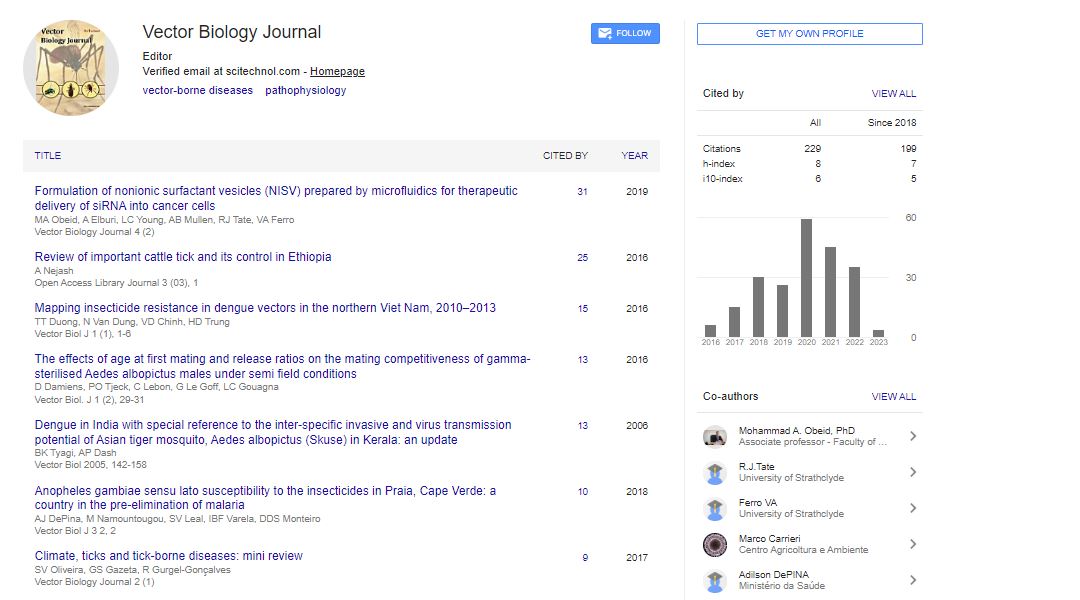Perspective, Vector Biol Vol: 8 Issue: 2
Vectorial Capacity: Its Components, Limitations and Challenges
Quynh Holmes*
1Department of Biological Sciences, University of Cincinnati, Cincinnati, United States of America
*Corresponding Author: Quynh Holmes,
Department of Biological Sciences,
University of Cincinnati, Cincinnati, United States
E-mail: holmes.uynh990@ut.edu
Received date: 30 May, 2023, Manuscript No. VBJ-23-107342;
Editor assigned date: 02 June, 2023, PreQC No. VBJ-23-107342 (PQ);
Reviewed date: 16 June, 2023, QC No. VBJ-23-107342;
Revised date: 23 June, 2023, Manuscript No. VBJ-23-107342 (R);
Published date: 30 June, 2023 DOI: 10.4172/2473-4810.1000268
Citation: Holmes Q (2023) Vectorial Capacity: Its Components, Limitations and Challenges. Vector Biol 8:2.
Description
Vectorial capacity is a fundamental concept in the field of epidemiology and public health, particularly in understanding the dynamics of vector-borne diseases. It is a quantitative measure that combines multiple factors to assess the potential of a vector population to transmit a particular pathogen to human populations. By considering various ecological, biological, and behavioral factors, vectorial capacity provides insights into the risk of disease transmission and assists in the development of effective prevention and control strategies. This article aims to delve into the concept of vectorial capacity, its components, and its significance in disease control.
Vectorial capacity is defined as the number of new infections transmitted to susceptible individuals per unit time, per unit vector population, assuming no immunity or other mitigating factors. It serves as a mathematical tool to estimate the basic reproduction number of a vector-borne disease, which is the average number of secondary infections caused by a single infected individual introduced into a completely susceptible population. Understanding vectorial capacity helps in predicting the potential scale and intensity of disease transmission and aids in devising targeted interventions.
Components of vectorial capacity
Vectorial capacity is determined by various factors, including vector competence, host-vector contact rates, vector population dynamics, and the extrinsic incubation period.
Vector competence: Vector competence refers to the ability of a vector species to acquire, maintain, and transmit a particular pathogen. It depends on various factors such as the vector's susceptibility to infection, the pathogen's ability to replicate within the vector, and the vector's capacity to transmit the pathogen to a new host. Vector competence is often assessed through laboratory experiments, where the vector's ability to acquire the pathogen from an infected host and subsequently transmit it to a susceptible host is measured.
Host-vector contact rates: The frequency and duration of interactions between infected hosts and vectors significantly influence disease transmission. Factors affecting host-vector contact rates include the density and behavior of both the human and vector populations. Increased contact rates can occur through factors such as population movements, changes in land use, or environmental factors that attract or favor vector populations. Understanding the patterns of host-vector interactions helps in identifying high-risk areas and implementing appropriate control measures.
Vector population dynamics: The population dynamics of vectors, including their abundance, distribution, and longevity, play a crucial role in determining vectorial capacity. Factors such as breeding sites, availability of suitable hosts, climate conditions, and vector control measures impact vector population dynamics. By monitoring and modeling vector populations, public health officials can anticipate changes in disease transmission patterns and plan interventions accordingly.
Extrinsic incubation period: The extrinsic incubation period is the time required for a pathogen to develop and multiply within the vector before it can be transmitted to a new host. This period varies among different vector-borne diseases and can be influenced by environmental conditions such as temperature and humidity. Understanding the extrinsic incubation period helps in predicting the time required for a vector to become infectious and in devising control strategies targeting specific stages of the pathogen's development within the vector.
Significance of vectorial capacity
Understanding vectorial capacity is essential for effective disease prevention and control strategies. By quantifying the risk of disease transmission, public health authorities can prioritize interventions based on the areas and populations at highest risk. This knowledge allows for targeted vector control measures, such as insecticide-treated bed nets, indoor residual spraying, and environmental management of breeding sites. Additionally, vectorial capacity estimation aids in evaluating the effectiveness of interventions and monitoring changes in disease transmission dynamics over time.
Limitations and challenges
While vectorial capacity provides valuable insights into disease transmission, it is important to acknowledge its limitations and associated challenges. Vectorial capacity models are based on simplifying assumptions and may not capture the full complexity of vector-borne disease systems. Additionally, the accuracy of vectorial capacity estimates depends on the availability and quality of data on vector populations, pathogen characteristics, and host-vector interactions. Challenges in data collection, especially in resourcelimited settings, can limit the precision of vectorial capacity predictions.
Vectorial capacity serves as a powerful tool for understanding the dynamics of disease transmission by vector-borne pathogens. By considering factors such as vector competence, host-vector contact rates, vector population dynamics, and the extrinsic incubation period, it quantifies the potential for disease spread and informs targeted control strategies. However, ongoing research and data collection efforts are necessary to refine and improve the accuracy of vectorial capacity estimates. By leveraging this knowledge, public health professionals can enhance their ability to prevent and control vectorborne diseases, ultimately reducing the burden on human populations worldwide.
 Spanish
Spanish  Chinese
Chinese  Russian
Russian  German
German  French
French  Japanese
Japanese  Portuguese
Portuguese  Hindi
Hindi 